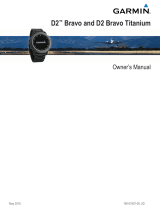
Tips for Getting Your Training Status.............................. 16
About VO2 Max. Estimates.................................................. 16
Getting Your VO2 Max. Estimate for Running................ 16
Getting Your VO2 Max. Estimate for Cycling.................. 17
Recovery Time..................................................................... 17
Viewing Your Recovery Time.......................................... 17
Recovery Heart Rate........................................................... 17
Training Load....................................................................... 17
Viewing Your Predicted Race Times................................... 17
About Training Effect........................................................... 17
Heart Rate Variability and Stress Level............................... 18
Viewing Your Heart Rate Variability and Stress Level.... 18
Performance Condition........................................................ 18
Viewing Your Performance Condition............................. 18
Lactate Threshold................................................................ 18
Performing a Guided Test to Determine Your Lactate
Threshold
........................................................................ 18
Getting Your FTP Estimate.................................................. 18
Conducting an FTP Test................................................. 19
Pulse Oximeter............................................................. 19
Viewing the Pulse Oximeter Widget......................................... 19
Turning On All-Day Acclimation Mode...................................... 19
Turning On Manual Acclimation Mode..................................... 19
Tips for Erratic Pulse Oximeter Data........................................ 19
Training......................................................................... 19
Setting Up Your User Profile.....................................................19
Fitness Goals....................................................................... 19
About Heart Rate Zones...................................................... 20
Setting Your Heart Rate Zones....................................... 20
Letting the Device Set Your Heart Rate Zones............... 20
Heart Rate Zone Calculations......................................... 20
Setting Your Power Zones................................................... 20
Activity Tracking........................................................................20
Auto Goal............................................................................. 20
Using the Move Alert............................................................21
Sleep Tracking..................................................................... 21
Using Automated Sleep Tracking....................................21
Using Do Not Disturb Mode............................................ 21
Intensity Minutes.................................................................. 21
Earning Intensity Minutes................................................ 21
Garmin Move IQ™............................................................... 21
Activity Tracking Settings..................................................... 21
Turning Off Activity Tracking........................................... 21
Workouts...................................................................................21
Following a Workout From the Web.....................................21
Starting a Workout............................................................... 21
About the Training Calendar................................................ 22
Using Garmin Connect Training Plans............................ 22
Interval Workouts...................................................................... 22
Creating an Interval Workout............................................... 22
Starting an Interval Workout................................................ 22
Stopping an Interval Workout...............................................22
Segments..................................................................................22
Strava™ Segments.............................................................. 22
Viewing Segment Details..................................................... 22
Racing a Segment............................................................... 22
Setting a Segment to Adjust Automatically.......................... 23
Using Virtual Partner®.............................................................. 23
Setting a Training Target.......................................................... 23
Cancelling a Training Target................................................ 23
Racing a Previous Activity........................................................ 23
Personal Records..................................................................... 23
Viewing Your Personal Records.......................................... 23
Restoring a Personal Record............................................... 23
Clearing a Personal Record................................................. 23
Clearing All Personal Records............................................. 23
Clock.............................................................................. 24
Setting an Alarm....................................................................... 24
Deleting an Alarm................................................................ 24
Starting the Countdown Timer.................................................. 24
Using the Stopwatch................................................................. 24
Adding Alternate Time Zones................................................... 24
Setting Clock Alerts.................................................................. 24
Syncing the Time with GPS...................................................... 24
Navigation..................................................................... 24
Saving Your Location............................................................... 24
Editing Your Saved Locations.............................................. 24
Projecting a Waypoint............................................................... 24
Navigating to a Destination....................................................... 24
Navigating to a Point of Interest............................................... 25
Points of Interest.................................................................. 25
Creating and Following a Course on Your Device.................... 25
Creating a Round-Trip Course..................................................25
Marking and Starting Navigation to a Man Overboard
Location.................................................................................... 25
Navigating with Sight 'N Go...................................................... 25
Navigating to Your Starting Point During an Activity................ 25
Navigating to the Starting Point of Your Last Saved Activity.... 25
Stopping Navigation................................................................. 26
Map........................................................................................... 26
Viewing the Map.................................................................. 26
Saving or Navigating to a Location on the Map................... 26
Navigating with the Around Me Feature.............................. 26
Compass...................................................................................26
Altimeter and Barometer........................................................... 26
Altimeter Readings...............................................................26
History........................................................................... 26
Using History............................................................................ 26
Multisport History................................................................. 27
Viewing Your Time in Each Heart Rate Zone...................... 27
Viewing Data Totals.................................................................. 27
Using the Odometer..................................................................27
Deleting History........................................................................ 27
Customizing Your Device............................................ 27
Aviation Settings....................................................................... 27
Activities and App Settings....................................................... 27
Customizing the Data Screens............................................ 28
Adding a Map to an Activity................................................. 28
Alerts.................................................................................... 28
Setting an Alert................................................................28
Activity Map Settings............................................................29
Routing Settings...................................................................29
Auto Lap...............................................................................29
Marking Laps by Distance............................................... 29
Enabling Auto Pause........................................................... 29
Enabling Auto Climb............................................................ 29
3D Speed and Distance....................................................... 30
Turning On and Off the Lap Key.......................................... 30
Using Auto Scroll................................................................. 30
UltraTrac.............................................................................. 30
Power Save Timeout Settings..............................................30
Changing the Order of an Activity in the Apps List................... 30
Widgets..................................................................................... 30
Customizing the Widget Loop.............................................. 31
Altimeter............................................................................... 31
Temperature........................................................................ 31
METAR................................................................................ 31
VIRB Remote....................................................................... 31
Controlling a VIRB Action Camera.................................. 31
Controlling a VIRB Action Camera During an Activity..... 31
Using the Stress Level Widget............................................. 32
ii Table of Contents




















